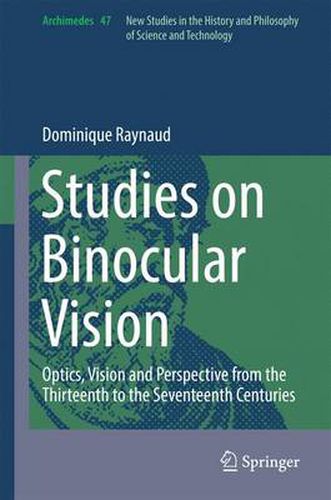Readings Newsletter
Become a Readings Member to make your shopping experience even easier.
Sign in or sign up for free!
You’re not far away from qualifying for FREE standard shipping within Australia
You’ve qualified for FREE standard shipping within Australia
The cart is loading…






This title is printed to order. This book may have been self-published. If so, we cannot guarantee the quality of the content. In the main most books will have gone through the editing process however some may not. We therefore suggest that you be aware of this before ordering this book. If in doubt check either the author or publisher’s details as we are unable to accept any returns unless they are faulty. Please contact us if you have any questions.
This book clarifies the interrelationship between optics, vision and perspective before the Classical Age, examining binocularity in particular. The author shows how binocular vision was one of the key juncture points between the three concepts and readers will see how important it is to understand the approach that scholars once took. In the Middle Ages and the Renaissance, the concept of Perspectiva - the Latin word for optics - encompassed many areas of enquiry that had been viewed since antiquity as interconnected, but which afterwards were separated: optics was incorporated into the field of physics (i.e., physical and geometrical optics), vision came to be regarded as the sum of various psycho-physiological mechanisms involved in the way the eye operates (i.e., physiological optics and psychology of vision) and the word ‘perspective’ was reserved for the mathematical representation of the external world (i.e., linear perspective).
The author shows how this division, which emerged as a result of the spread of the sciences in classical Europe, turns out to be an anachronism if we confront certain facts from the immediately preceding periods. It is essential to take into account the way medieval scholars posed the problem - which included all facets of the Latin word perspectiva - when exploring the events of this period. This book will appeal to a broad readership, from philosophers and historians of science, to those working in geometry, optics, ophthalmology and architecture.
$9.00 standard shipping within Australia
FREE standard shipping within Australia for orders over $100.00
Express & International shipping calculated at checkout
This title is printed to order. This book may have been self-published. If so, we cannot guarantee the quality of the content. In the main most books will have gone through the editing process however some may not. We therefore suggest that you be aware of this before ordering this book. If in doubt check either the author or publisher’s details as we are unable to accept any returns unless they are faulty. Please contact us if you have any questions.
This book clarifies the interrelationship between optics, vision and perspective before the Classical Age, examining binocularity in particular. The author shows how binocular vision was one of the key juncture points between the three concepts and readers will see how important it is to understand the approach that scholars once took. In the Middle Ages and the Renaissance, the concept of Perspectiva - the Latin word for optics - encompassed many areas of enquiry that had been viewed since antiquity as interconnected, but which afterwards were separated: optics was incorporated into the field of physics (i.e., physical and geometrical optics), vision came to be regarded as the sum of various psycho-physiological mechanisms involved in the way the eye operates (i.e., physiological optics and psychology of vision) and the word ‘perspective’ was reserved for the mathematical representation of the external world (i.e., linear perspective).
The author shows how this division, which emerged as a result of the spread of the sciences in classical Europe, turns out to be an anachronism if we confront certain facts from the immediately preceding periods. It is essential to take into account the way medieval scholars posed the problem - which included all facets of the Latin word perspectiva - when exploring the events of this period. This book will appeal to a broad readership, from philosophers and historians of science, to those working in geometry, optics, ophthalmology and architecture.